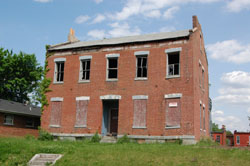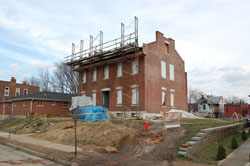New Life for Drosten House
 |
| Drosten House at 3324 Missouri Ave in 2009 |
The 145 year old two story brick residence at 3324 Missouri Avenue has suffered from the ravages of decades of neglect. While unoccupied, the massive limestone foundation subsided, the brick bonding on the façade sagged, windows were missing and the attic suffered a major fire. Plagued with numerous structural issues, the dwelling was placed on Landmarks' Most Endangered List in 2009 to raise awareness of this historic resource of St. Louis. The future of 3324 Missouri appeared bleak. Due to its large size, the property would be difficult to rehabilitate. However, in 2010 the property was purchased by WJL Companies from the St. Louis Land Reutilization Authority. Over the past year, the building has been undergoing a massive rehabilitation.
In 1867, William Drosten purchased several lots on the east side of Missouri Avenue in the former St. Louis City Commons. Immediately, a two story brick home with Federal elements was constructed for Drosten on his newly purchased lots. A native of Bonn, Germany, Drosten fled his country in 1849 after participating in the failed March Revolution the previous year. After arriving in St. Louis, he established a successful confectionary and coffee shop at 34 North 3rd Street. Once attaining sufficient wealth from his trade, Drosten retired to his home on Missouri Avenue where he cultivated rare plants and flowers. Drosten's son, Frederick, lived in house until 1883 when he embarked on a career as a watchmaker. Within a few years, Frederick had the largest jewelry and watchmaking establishment in St. Louis. After Drosten's death in the Spring of 1885, his widow Rosalie continued to live in the home for the next twenty five years.
 |
| Drosten House January 2012 |
WJL Companies hired architect Peter Hammond to design a modern living space within the historic home. Hammond was instrumental in supervising the rehabilitation of Union Station's Grand Hall. He was also architect for the rehabilitation of 2608-10 Cherokee Street, which won Landmarks' Most Enhanced Award in 2011. The first step of the rehabilitation was tackling the structural failures of the foundation. The limestone blocks were fixed in several places and the façade wall required over nine months of repairs. Several of the St. Louis Limestone headers had to be removed and were replaced with Indiana Limestone. The rehabilitation of the Drosten House will include two fee simple town homes separated by a twelve inch concrete block wall. The separation of the dwelling fits the historic character of the home. After her husband's death, Rosalie Drosten separated the single family home into a two family flat to supplement her income. A garage will be designed and constructed into the hill at the rear of the property. The flat roof of the garage will also serve as a deck. Since the property is a contributing resource to the Benton Park Historic district, the rehabilitation expenses will be offset by state and federal tax credits managed by Melinda Stewart. Also, the Benton Park Housing Corporation, JoAnn Vatcha from Community Development Administration and Alderman Ken Ortmann were all personally invested and involved in the rehabilitation process. The entire rehabilitation is scheduled to be finished by September 2012.
